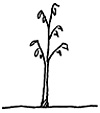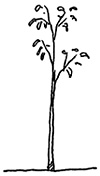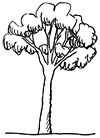Managing tree density
The density of trees has a large bearing on carbon storage and pasture production. The basic principle for maintaining or increasing tree densities is to make sure there are enough new trees to replace, or add to, the existing canopy trees.
But not all new trees are the same, as most eucalypts progress through distinct life stages before they develop into mature trees, and each life stage has a different level of tolerance to grazing and fire. This means that the management actions for maintaining or increasing tree density will vary, depending on what types of new trees are present.
Whether the landholder aims for typical large tree densities for the vegetation type (for maximum carbon) or reduced tree densities (for increased pasture production) it is important to understand how to manage different tree life stages to achieve the tree density required.
Life stages
Before they develop into mature trees, the life stages of eucalypts that develop a lignotuber are seedlings, short saplings and tall saplings.
The traits of these life stages that are relevant to management are summarised in the table.
Management actions for the recruitment and conservation of trees at the different life stages are summarised below.
|
Life stage |
Height (approx) |
Resprouting: lignotuber |
Resprouting: epicormic |
Tolerance: grazing |
Tolerance: fire |
|---|---|---|---|---|---|
|
|
Up to ~20cm |
no |
no |
Unlikely to survive if most shoots are removed |
Unlikely to survive fire |
|
|
20–150 cm |
yes |
no |
Likely to survive and resprout from base if most shoots are removed. |
Likely to survive and resprout from base if most shoots are killed or burnt. |
|
|
> 150cm |
yes |
no |
Probably beyond the reach of most herbivores; can resprout from base and upper stems/branches. |
Likely to survive and resprout from upper stems/branches and base. |
|
|
Canopy height |
yes |
no |
Probably beyond the reach of most herbivores; can resprout from base and upper stems/branches. |
Likely to survive and resprout from upper stems/branches and base |
Seedlings
- Seedling establishment will be more successful when periods of unusually high rainfall coincide with, and continue after, seeds are released.
- If using manual or machine seeding to establish seedlings, try to do this when a period of unusually high rainfall is expected.
- Reducing the amount of herbage before seed drop (by slashing, grazing, or low-severity fire) may also help seedling establishment.
- Prevent livestock and other herbivores from entering the area until seedlings develop into short saplings.
- Protect from fire.
Short saplings
- This life stage is still within the reach of most herbivores, so grazing pressure may need management until short saplings develop into tall saplings.
- Reduce stocking rates and/or control or exclude native and feral herbivores if grazing is damaging saplings.
- Protect from fire until short saplings develop into tall saplings.
Tall saplings
- No special grazing management should be required if enough tall saplings are present, as these are unlikely to be damaged by grazing.
- Protect from high severity fires.
Tree density
Increase tree density
Tree density can be increased by encouraging the establishment and growth of seedlings and/or saplings, so that the dying mature trees are replaced at the same rate by new trees growing into the canopy. The exact number of seedlings and saplings needed to produce a mature tree is difficult to define, as many factors will influence the survival and growth of seedlings and saplings (such as rainfall, fire, grazing).
A rough estimate of replacement ratios is: 30 seedlings are likely to provide 10 short saplings, which are likely to provide 5 tall saplings, which are likely to provide 1 mature tree.
These replacement ratios are estimates based on ideal growing conditions, and the appropriate management of grazing and fire for the different life stages.
Maintain tree density
To maintain tree density, the dying mature trees should be replaced at the same rate by new trees growing into the canopy. The time between tree death and replacement can be minimised by conserving a ‘bank’ of tall saplings scattered throughout the site.
When a mature tree dies, it is likely that nearby saplings will grow to replace it. Once again, the number of tall saplings needed to replace a mature tree will depend on many factors, but 5 saplings per mature tree may be the minimum required.
If there are no tall saplings present, it is likely that larger numbers of short saplings and seedlings will be required to replace a mature tree, given the generally higher mortality rate of these earlier tree life stages. The replacement ratios provided above under ‘increase tree density’ can be used as a rough guide for maintaining tree density in mature eucalypt open-forests.
The growth rate of eucalypts, higher rates of mortality during droughts, and the impacts of dieback and insect pests should all be considered when managing tree densities and preparing for tree replacement. A larger bank of saplings and small trees may reduce pasture production but is more likely to enable the rapid replacement of large trees, and the maintenance of maximum carbon levels.



 Seedling
Seedling Short seedling
Short seedling Tall sapling
Tall sapling Mature tree
Mature tree